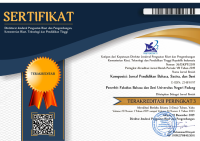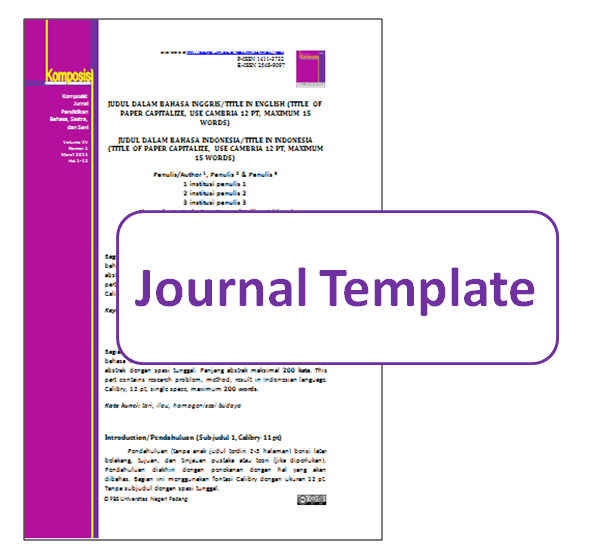The Application of Aleatoric Technique through Graphic Notation in the Choral Composition “Acumalaka”
Abstract
This article examines the use of aleatoric techniques through graphic notation in the choral music composition Acumalaka. It aims to demonstrate how aleatoric techniques and graphic notation can enhance artistic quality and musical expression. The composition process applied the practice-led research method, with the researcher serving as both composer and conductor. This approach involved the direct creation of the piece, alongside observing the choir's rehearsal and performance. Additionally, interviews with 14 singers were conducted to explore their experiences interpreting graphic notation and adapting to the creative freedom that aleatoric techniques allow. The collected data was analyzed thematically, combining critical reflections on the creative process with the singers' insights. Findings indicate that using aleatoric techniques through graphic notation enriched the musical dynamics, fostered creativity, and strengthened interactions among choir members. Moreover, aleatoric techniques and graphic notation can support innovative and collaborative musical experiences.
Keywords
Full Text:
PDFReferences
Amazonas, M., Castro, T., Kienem, J. G., de Freitas, R., & Gadelha, B. (2020). Composing aleatoric music through interaction: A composition environment based on interaction with mobile technologies for public spaces. Per Musi, 2020(40). https://doi.org/10.35699/2317-6377.2020.26077
Bernstein, D. W. (1996). James Pritchett. The Music of John Cage. New York: Cambridge University Press, 1993. Music Theory Spectrum, 18(2), 265–273. https://doi.org/10.2307/746027
Bishop, L. (2024). Togetherness in musical interaction [version 1; peer review: 2 approved, 3 approved with reservations]. Routledge Open Research, 3(16). https://doi.org/10.12688/routledgeopenres.18202.1
Boulez, P., Thévenin, P., & Walsh, S. (1991). Stocktakings from an Apprenticeship. Clarendon Press. https://books.google.co.id/books?id=3TsE9rJl81QC
Brun, C., & Exbrayat, J.-M. (2022). The Effects of Sounds and Music on Cells and Organisms: A Promising and Developing Area of Research. Athens Journal of Sciences, 9(3), 157–176. https://doi.org/10.30958/ajs.9-3-1
Buj Corral, M. (2018). Sinestesias en la notación gráfica: lenguajes visuales para la representación del sonido. Cuadernos de Música, Artes Visuales y Artes Escénicas, 14(1), 45–64. https://doi.org/10.11144/javeriana.mavae14-1.seln
Campbell, E., & O’Hagan, P. (Eds.). (2016). Pierre Boulez Studies. In Pierre Boulez Studies (pp. i–ii). Cambridge University Press. https://www.cambridge.org/core/product/3DD754B067EC9EA24D7D2455C28DDC8E
Delius, J. A. M., & Müller, V. (2023). Interpersonal synchrony when singing in a choir. In Frontiers in Psychology (Vol. 13). Frontiers Media S.A. https://doi.org/10.3389/fpsyg.2022.1087517
Galbreath, D. J., & Conservatoire, R. B. (2018). Conceptualising Choral Play: The Creative Experience of Aleatory Choral Music PhD thesis (Volume I).
Gimon, K. (2024). Elements. Https://Www.Katerinagimon.Com. https://www.katerinagimon.com/elements.html
Hannula, M., Suoranta, J., & Vaden, T. (2014). Artistic Research Methodology. Peterlang. https://www.researchgate.net/publication/347497267_Artistic_Research_Methodology/citation/download
Hope, C. (2020). The Future is Graphic: Animated notation for contemporary practice. Organised Sound, 25, 187 - 197. https://doi.org/10.1017/S1355771820000096.
Iddon, M. (2009). John Cage and David Tudor: Correspondence on Interpretation and Performance. 1–225. https://doi.org/10.1017/CBO9781139013727
Native Instruments. (2024). MYSTERIA. Native Instruments.Com. https://www.native-instruments.com/en/press-area/music-production/mysteria/?srsltid=AfmBOoqgNSK3xUR9Ew3T7DQZL2zGEG42Va8zve7o9vhGg9KzREyl5ksA
Mack, D. (2004). Sejarah Musik Jilid IV (4th ed.). Pusat Musik Liturgi.
Mäkelä, M. (2007). Knowing Through Making: The Role of the Artefact in Practice-led Research. Knowledge, Technology & Policy, 20(3), 157–163. https://doi.org/10.1007/s12130-007-9028-2
Meeùs, N. (2019). Music Notation as Analysis. Analysis and Theory of Music, 8–9. https://hal.science/hal-04027299
Nelson, R. (2022). Practice as Research in the Arts (and Beyond). In Practice as Research in the Arts (and Beyond). https://doi.org/10.1007/978-3-030-90542-2
Nomuunaa Battogtokh, & Oyunbadrakh Baynjargal. (2024). Problems of Music Interpretation and Its Expression: On the Example of the Violin. Philosophy Study, 14(02), 73–80. https://doi.org/10.17265/2159-5313/2024.02.004
Palombini, C. (1993). Machine Songs V: Pierre Schaeffer: From Research into Noises to Experimental Music. Computer Music Journal, 17(3), 14–19. https://doi.org/10.2307/3680939
Pamungkas, Y. W. (2020). Penggunaan Aturan Ular Tangga dalam Musik Aleatorik Berbasis Serialisme Integral. Journal of Music Science, Technology, and Industry, 3(2), 201–222. https://doi.org/10.31091/jomsti.v3i2.1157
Parsons, I. (2021). BEYOND THE HORIZON: THE DEPICTION OF TIME IN KARLHEINZ STOCKHAUSEN’S KLANG. Tempo, 75, 6–16. https://doi.org/10.1017/S0040298220000649
Pritchett, J. (1993). The music of John Cage. Cambridge [England] ; New York : Cambridge University Press. https://archive.org/details/musicofjohncage0000prit
Sauer, T. (2009). Notations 21 / Theresa Sauer. In Notations 21: Graphic Notation in Twentieth-Century Music (1st ed.). Mark Batty Publisher.
Sonokinetic. (2024). A 48 piece Orchestral Cinematic Choir Next Generation Sample Library. Sonokinetic Boutiqe Sampling. https://www.sonokinetic.net/products/classical/tuttivox/?srsltid=AfmBOoqZioh9X0t4B-VAt4Z6uQvA1yATRKpjM32zpc8Fd614K-UMUAmP
Swed, M. (2013). Mezzo-soprano Cathy Berberian is due for a rediscovery. Los Angeles Times Music Critic. https://www.latimes.com/entertainment/arts/culture/la-et-cm-cathy-berberian-notebook-20130619-story.html
Vickery, L. (2010). Mobile Scores and Click-Tracks: Teaching Old Dogs. Proceedings of Australasian Computer Music Conference, 63–70.
DOI: https://doi.org/10.24036/komposisi.v25i2.131069
Refbacks
- There are currently no refbacks.
Copyright (c) 2024 Komposisi: Jurnal Pendidikan Bahasa, Sastra, dan Seni

This work is licensed under a Creative Commons Attribution-NonCommercial 4.0 International License.
Komposisi: Jurnal Pendidikan Bahasa, Sastra, dan Seni, a peer-reviewed online journal in languages, literature, and arts education.
Printed ISSN 1411-3732, Online ISSN 2548-9097.
Currently, Komposisi: Jurnal Pendidikan Bahasa, Sastra, dan Seni is indexed by:












